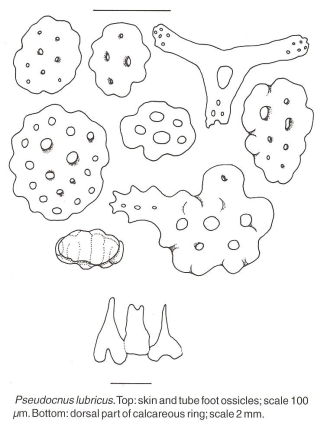Pseudocnus lubricus is a small, white to brownish black sea cucumber, often with fine black specks on the dorsum. It can grow up to 4 cm long. It is bluntly pointed at each end when retracted. The dorsal side varies from almost black to yellowish white. The underside is usually lighter than the top. The tube feet on the ventrum are well developed in double rows, with some scattered between the rows. On the dorsum, the tube feet are scattered and appear as lighter coloured bumps or dimples. The 10 tentacles are equal in size and extend upwards at an angle from the body which is usually firmly attached to the substratum.
Skin ossicles: vary from thick, knobbed, four-holed buttons to larger knobbed plates, some are elongated and quite thick with a spiny handle at one end, often referred to as pine-cone ossic1es; three-armed ossicles from tube feet.
Lambert (in press) has placed this species and C. curata into the genus Pseudocnus based on the distribution of tube feet, the complex button ossicles and DNA evidence.
Similar SpeciesIn the literature, Pseudocnus lubricus has been confused with C. curata, C. pseudocurata and C. piperata. What used to appear in identification keys as C. lubrica - the small black aggregating species in the Juan de Fuca Strait region - is actually Pseudocnus curatus (=C. curata). True P. lubricus (=C. lubrica) is usually plain creamy white to brown, and often speckled with black. Consult the descriptions of the above species for comparative details. Cucumaria fisheri astigmatus Wells, 1924 also as Pseudocnus astigmatus (Wells, 1924) is considered to be a junior synonym of C. lubrica Clark (Arndt, Marquez, Lambert and Smith 1996), but C. lubrica has been revised to P. lubricus by Lambert (in press). The black spots of C. piperata are blotches rather than specks, and they occur all over the body rather than just on the dorsal surface. C. piperata normally buries itself in the substratum or under rocks.
